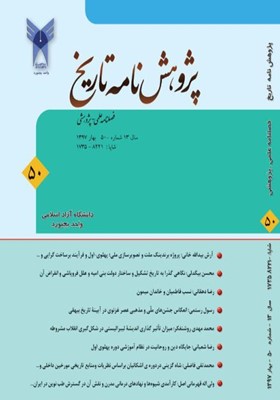جایگاه دین وروحانیت در نظام آموزشی دوره پهلوی اول
محورهای موضوعی : مباحث معرفتی و روش شناختی و تاریخ پژوهیرضا شعبانی 1 , قباد منصوربخت 2 , فرشید مهری 3 *
1 - استاد دانشگاه آزاد اسلامی واحد علوم تحقیقات،گروه تاریخ، تهران
2 - استادیار دانشگاه شهید بهشتی تهران، گروه تاریخ
3 - دانشجوی دکتری تاریخ ایران بعد از اسلام، دانشگاه آزاد واحد علوم وتحقیقات تهران
کلید واژه: برنامه ریزی, رضاشاه پهلوی, روحانیت, محتوای کتب درسی دینی, نظام آموزشی &emsp, ,
چکیده مقاله :
آنچه که در این مقاله با عنوان جایگاه دین و روحانیت در نظام آموزشی و دوره پهلوی اول مورد بررسی قرار گرفت حاوی مطالبی است که نحوه و چگونگی برخورد پهلوی اول نسبت به روحانیت در عرصه آموزشی و جایگاه دین در برنامهریزی و محتوای کتاب درسی را نشان می دهد. با توجه به اینکه حاکمیت در این زمان درصدد نوسازی نظام آموزشی مبتنی بر ناسیونالیسم باستانگرا و سکولاریسم غربگرا بوده دستگاه فرهنگی رژیم پهلوی درصدد برآمد تا حضور روحانیت در نظام آموزشی را کاسته و در برنامهها و محتوای متون درسی دینی محدودیتهایی را برای آنها به وجود آورد. ایجاد هویت جدید ایرانی براساس توجه به نهادهای زیربنایی همچون نظام آموزشی مهمترین رویکرد رژیم پهلوی اول در همسان سازی توده با حاکمیت است که در این راستا ملی گرایی افراطی و تجدد گرایی با الگوی غربی مهمترین شاخصه های نظری رژیم پهلوی اول بوده است. همانطور که گفته شد نظام آموزشی مهمترین عرصه اجرایی شاخصههای مطروحه ایدئولوژی متجدد رژیم بوده و برای رسیدن به مولفههای نظری مهمترین اقدامش کاستن نقش روحانیت در نهاد تعلیم و تربیت و برنامه درسی دینی در کتب درسی و برنامههای آموزشی بوده است.
What is studied in this article as the position of religion and the clergymen within the educational system and the First Pahlavi Era contains the materials that indicate the method of reaction of the first Pahlavi toward the clergymen within the education field and the position of the religion in planning and the context of the course books. Hence, the government was trying to renovate the educational system based on the ancient oriented nationalism and western secularism, the cultural system of the Pahlavi regime tried to decrease the presence of the clergymen in educational system and made some restrictions for them regarding the programs and the context of the courses of religion. Creation of a new Iranian identity based on focusing on the infrastructural institutes such as educational system, was the most important strategy of the first Pahlavi regime in order to homogenize the common people with the governing body. In this regard, extreme nationalism and western-based modernism were the most important ideologies of the first Pahlavi regime. As it was mentioned, the educational system was the most important context where the mentioned ideologies were executed. In order to achieve the ideological components, Pahlavi's most important actions were decreasing the role of the clergymen in educational institutes, the religion course books and the educational programs.
_||_

